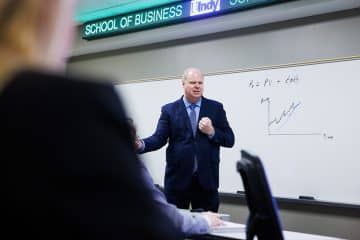Looking Beyond Business School: How to Craft the Perfect Résumé For Your Dream Job
If you are nearing your business school graduation date, you are likely thinking about next steps, one of which should be searching for a job to show off your new skillset . To land your dream job, you’ll need to make sure your résumé is up to snuff. Learn how to perfect your résumé from Lewis University’s Associate Professor of Organizational Leadership, Dr. Sheila Boysen:
A resume does not land you the job – it’s a tool for getting responses, phone calls, and interviews. Because of today’s highly competitive job market, your resume needs to set you apart from both your internal and external competition. It should:
- Be a brief overview to sell your knowledge, skills and experience in an accomplishment and metrics- driven way to position yourself as an ideal candidate able to add immediate value (it’s not a biography)
- Demonstrate your value and contributions as opposed to just listing your day-to-day responsibilities
- Keep the reader engaged with active language to describe your achievements and responsibilities
- Be free of excessive repetition
- Provide scope wherever possible (e.g., budget sizes, team sizes, size of businesses, accounts managed, etc.) and quantify as much as possible (e.g., percentages or hard dollar values for growth/savings)
Core Components of an Effective Resume
Many of the main components of a résumé have changed in recent years to meet today’s brief résumé reviews. The average recruiter spends 6 seconds reviewing a résumé. Four seconds are spent looking at only four areas: 1) job titles, 2) companies, 3) start/end dates, and 4) education. Tips for maximizing today’s résumé sections:
Objective Title
The outdated objective statement (e.g., “Seeking opportunity to utilize my skills and advance my career with a company”) has been replaced with an objective title, which is a title (e.g., Senior Project Manager, Operations Executive, Sales Manager, etc.) listed at the top of the résumé to reflect what you are targeting for your job search. This immediately gives your readers some direction.
If you are sending the résumé to networking contacts, make the objective title more general or specific based on your goals. An example of a specific objective title could be “Senior Manager Specializing in Technical Operations & Quality Assurance” while a general title may be “Senior Operations Manager.” If you are responding to job ads, switch out the title to match the title in the job ad.
Summary Statement
This is your résumé’s version of a Professional Value Proposition. It can be a brief paragraph or a list of bullet points that provides a brief overview of what you have to offer. The goal of the summary is to communicate your value as quickly as possible. This summary typically covers:
- Years of service with your employer, years of experience in a specific area or field
- Industry expertise (if your job search is specific to industry/industries)
- What you specialize in and what makes you unique
- Types of results you deliver consistently and your approach in doing so
- Key Skills
A listing of key skills or areas of expertise can be three to five lines that include key words and terms from your skill set. This can be useful for key word optimization on Applicant Tracking Systems (ATS), which are used by potential employers to process, track, and filter online applications. You can modify and reprioritize this section based on the major key words related to the job you are applying to. Besides being useful for the ATS, it also visually stands out to readers and provides a quick glimpse.
Layout
Regardless of which format is used, the professional experience section should be laid out as clearly as possible, calling attention to the most important points. This can be done by listing a brief paragraph of day-to- day responsibilities and tasks followed by bullet points highlighting specific contributions, results, or major projects for each position or can be a list of concise bullets that are accomplishment focused. Avoid completely functional formats.
- Reverse Chronological Format jumps into the professional experience right after the summary and key skills sections, starting with the most recent position first and moving backward. This can be useful if you would like all of the information and contributions to be clearly linked to each previous employer.
- Functional format outlines skills and professional experience in a non chronological manner. Most frequently used for those looking to change career paths, or people new to their careers. It can be perceived that the individual is trying to hide gaps in employment by not listing professional experience in a chronological manner.
- Combination format lists a brief section of three to five highlights before the professional experience section to showcase specific examples that support your current goal. This section shouldn’t take up too much space in the résumé. Its main objective is to provide a snapshot of accomplishments to further back up statements made in the summary. This is typically useful for job seekers with quantifiable information to highlight, such as revenue growth, cost savings,or major projects and initiatives. It can also be useful if you have specific prior experience (i.e., industry-specific or function-specific) you would like to highlight as part of your current goal.
Additional Sections
Depending upon your experience, current career direction, and goals, you may also decide to add optional and/or recommended sections.
- Education: Education is typically listed at the end of the résumé; it can be useful to list before the professional experience section if you are entry level or if it is recent and relevant to your current direction.
- Affiliations & Community Involvement
- Professional memberships and volunteer activity can be listed at the bottom of the résumé. Depending on the amount of space available, you can provide more details or you can list only the role, organization, and length of service.
- Technical Skills
- Software and technical skills that you use on the job can be listed in a separate section at the bottom of the résumé. Make sure to highlight only the most relevant tools, software, and programs based on the jobs you are applying to. Include professional development or company sponsored seminars. If the technical skills section doesn’t take up too much space but is central to your job (such as a Software Engineer), you should list it at the top of the résumé, right before the professional experience section.
- Patents & Publications: Depending on your field, you may have contributed to patent applications or materials/presentations. You can provide a brief snapshot (preferably the most recent) in your résumé. If you have a lengthy list, you can include them on an addendum, which can be provided upon request or given to your interviewer once contact has been made.
- Awards & Professional Recognition
- Itemize corporate awards, honors, and endorsements received for outstanding achievements to confirm your high-standing reputation within the organization.
Resume Standards & Best Practices
Some general guidelines to follow as you evolve and refine your résumé in response to new opportunities:
- The standard and recommended length for a résumé is one full page or two full pages (avoid quarter or half pages). There may be an exception if you are in a highly scientific/technical field and require a CV. An addendum may be used for additional experience beyond these recommendations.
- Margins of a résumé should be no less than .5″ all around.
- Use a common font to avoid compatibility issues. Common fonts include Times New Roman, Arial, Calibri, Tahoma, Verdana, Cambria, Garamond, and Book Antiqua. Font size should be 10 pt. to 11.5 pt.
- Include active language and high-impact words throughout. Keep the tense consistently in present for current positions and in past for prior positions.
- Use implied first person or third person throughout; avoid using personal pronouns (I, me, my).
- Incorporate basic design elements (e.g., bolding and lines to separate section titles), but never a picture.
- List years of experience as 10+, 15+, or a maximum of 20+ in the summary. Avoid listing years for positions or education that go back more than 15-20 years (use “Prior to XXXX” instead).
- It can be acceptable to only list years of experience on résumés (2011-2012).
- Use “and” instead of ampersands (&) within content unless it’s part of a title or term (e.g., M&A).
- Avoid using very long lists of bullets or large blocks of text; break them into categories to provide a visual break.
- Don’t use text boxes or tables to list information (i.e., summary statements, key skills, etc.) or put the résumé in a PDF format if you are planning to submit the résumé online. It won’t be picked up by ATS.
Why Tailoring Works
To be competitive in today’s job market, your résumé must not only be well written, but tailored to each position you apply to. Tailoring your foundation résumé for the positions you target will have a major impact on your results!In addition to sending the message that you are a great fit for a position, a tailored résumé also helps with Applicant Tracking Software (ATS). Many companies rely on an ATS or on-line job boards, which use matching technology to compare an applicant’s résumé to a job posting.
Tailoring Your Resume Sections
When tailoring your résumé, focus on three key areas: Objective Title I Branding Statement, Professional Summary, and Skill Set. If you are highly interested in a role, you may want to focus on the accomplishments related to the position as well.
Objective Title/Branding Statement
You can either a) put the title from the job posting at the top of your own résumé orb) update the title of your résumé to closely match the title of the job posting and required skills. For instance, if you are an executive assistant or administrative professional looking at a job titled “Assistant to the Director of HR” you could simply put that exact title, or “Executive Assistant” at the top of your résumé. You can also show field and industry expertise on your title in the résumé such as “High-Tech Sales Executive.”
Professional Summary Statement
A professional summary demonstrates your unique value to a potential employer. You want to show you have as much of the desired experience and skills as possible. Review the job posting of interest and highlight any key phrases. Next, weave these key phrases into the professional summary section of your résumé. Don’t make this section too bulky, but make sure to show off your top qualification.
Skill Set
Present your specific strengths and expertise in an easy to read format using industry-related “buzz words” and key words from the job description. You can also prioritize the list while adding and removing items to ensure your résumé appears as relevant as possible to the job you apply to.
Abound: MBA connects business professionals to the right institution to pursue their MBA by focusing on what matters most. It’s not about how rich or famous a school is. It’s about finding the best place to pursue their goals and succeed. Lewis University is just one of our amazing schools that is committed to the academic, personal, and professional success of adult students.





